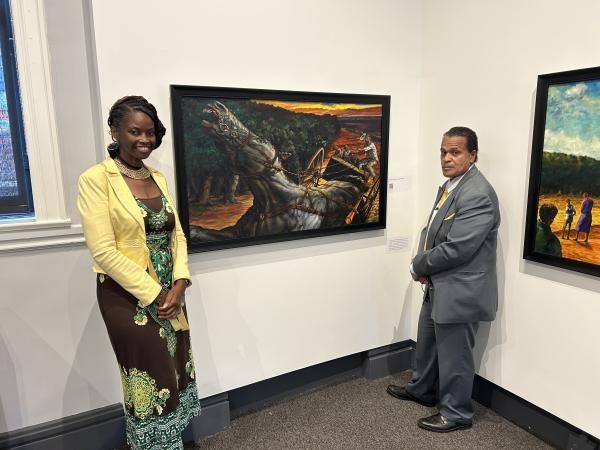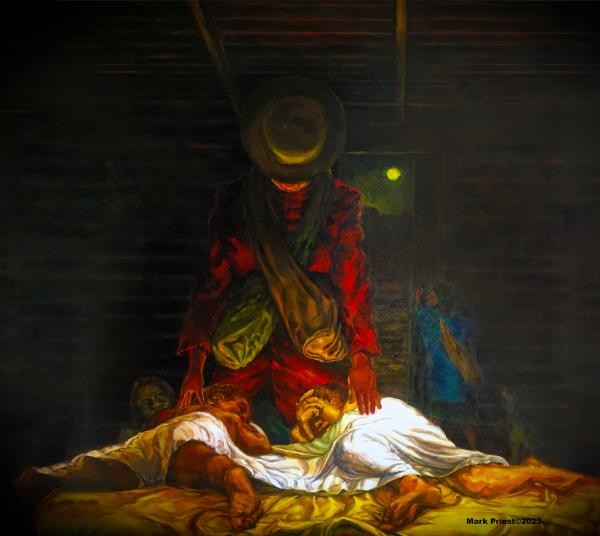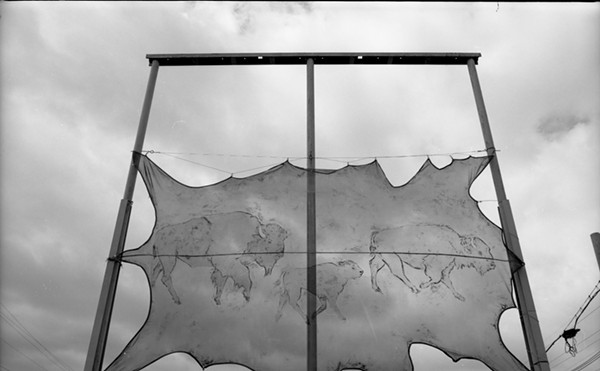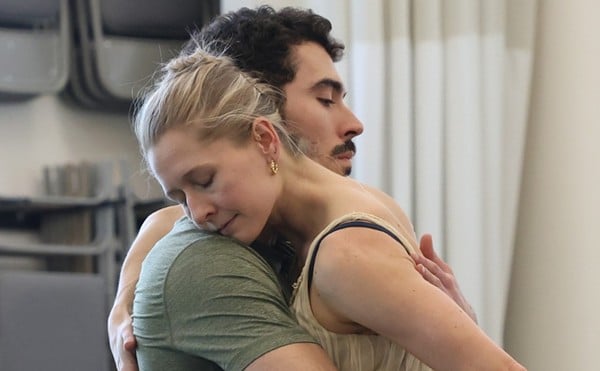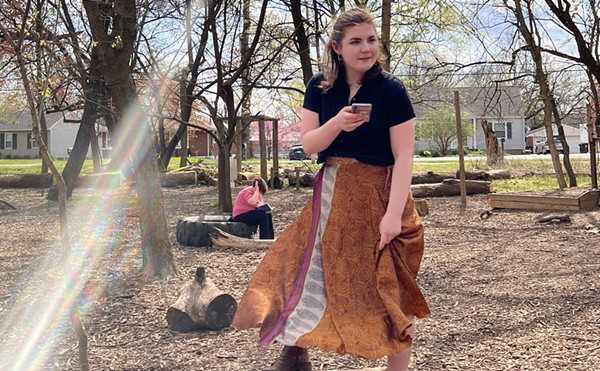This post comes to us through a partnership with GoSoIN to highlight stories of the events, attractions, and people of Southern Indiana.
For more than 20 years, Louisville-based artist Mark Priest has deeply researched the Underground Railroad, uncovering powerful and poignant narratives surrounding slavery and retelling those stories through his paintings, drawings, and other mediums.
Two of those stories are the focus of his latest exhibition, “The Underground Railroad: The Still Family & Charles Nalle,” which is currently spread across three rooms at New Albany’s Carnegie Center for Art & History.
Through vibrant paintings, intense drawings, early sketches, videos, and digital components, the exhibition presents a comprehensive and evocative examination of the subjects and their turbulent paths to freedom.
In two rooms, the exhibition explores the story of the Still family. The art follows the journey of Sidney Still, who worked to escape slavery in Maryland with her children and reunite with her husband Levin, who was previously able to buy his freedom and move to New Jersey. After being caught during a failed escape attempt, Sidney had to make a difficult choice. She decided to take her two daughters with her on the next attempt, but leave her two sons behind to increase the odds of successfully escaping. One of those sons would later die from cruelty, as noted by Priest’s research.
Sidney managed to escape, and many years later, her second son who had remained in slavery, Peter, was able to buy his freedom and find her. Peter then also met his younger brother — who was born after their mother escaped slavery — for the first time. That man was William Still, an abolitionist, activist, writer, and recorder whom the New York Times called the “Father of the Underground Railroad" in his obituary.
A third room is dedicated to large action-packed paintings of the rescue of Charles Nalle in Troy, New York. Nalle was born into slavery in Virginia, but escaped to Sandlake, New York, via the Underground Railroad as an adult. On April 27, 1860, he was captured by a slave catcher in Troy, but local abolitionists sprang into action, and a brawl on the street broke out in an attempt to save Nalle. Harriet Tubman was present and among those trying to help. Eventually, Nalle’s freedom was bought.
The exhibition is incredibly deep in detail and scope. Each drawing and painting represents a key piece of a narrative.
Priest told SoIN Tourism that he meticulously selects the presentation and focus for each painting.
“I carefully choose scenes that said a whole lot about the story — significant moments of the story,” Priest said. “These are significant highlights of the story that made me want to choose these to make them into drawings and then make them into paintings.”
The exhibition as a whole flows extremely well, with the pieces combining to create a novelistic approach that builds a detailed narrative.
Priest's wife, Licia, is instrumental in the research and what scenes are painted. Licia said that she’ll often circle pages in in-depth history books that might be a solid inspiration for a piece.
“Much like a movie, where those main scenes are what you see, it’s much like that,” Licia Priest said. “You don’t see everything in a movie, but you see what you need to see to get the story.”
Where The Research Began
The Priests started their research into the Underground Railroad when they were homeschooling their children.Licia said that when the children were learning about Harriet Tubman and local stops on the Underground Railroad, Priest's interest in the subject grew.
“They were studying about Harriet Tubman at the time, and thus, when Mark said he liked the story, that began our journey on the Underground Railroad, and our conductors were the historians that we met along the way, who directed us to other stories, other locations, other people, descendants of Harriet Tubman,” Licia said. “We went to different sites that were used on the Underground Railroad that were used to protect slaves who were running for freedom. That’s how it all started.”
Two decades later, Priest has created paintings that spotlight Tubman, Stewart’s Canal, Frederick Douglass, Charles Nalle, and the Still family.
Laura Wilkins, who is the museum operations leader at the Carnegie Center, said that Priest's artwork on Charles Nalle and the Still family was a great fit for the museum because it aligned with its other current exhibitions, including “Ordinary People, Extraordinary Courage: Men & Women of the Underground Railroad.”
“All of their research is very much in line with our exhibitions and presenting a narrative of the perils of escaping from slavery and using the mechanism of The Underground Railroad, and the sometimes hard choices that had to be made,” Wilkins said.
For the exhibition, the Priests created a multi-faceted project. While the paintings and drawings are the bulk — and the stars — of the show, aspects like the videos, the online elements, and the early sketches are windows into more historical context and the artistic process.
“I want people to know the whole story,” Mark said of all of the mediums used. “It gives you different dynamics of the story.”
“We’re able to capture every level of interest through the video, the written pieces, the images,” Licia added.
Capturing The Details
Not many exhibitions feature the artist’s early sketches of the work that appears in an exhibition, but “The Underground Railroad: The Still Family & Charles Nalle,” does, and it adds an interesting layer to a vibrant show. The sketches, which are various sizes and done at different stages, are held in glass casings, and provide interesting insight into the creation process.“I wanted you to see how I would work to get the best composition,” Priest said. “Those are all rough sketches. Any painter, true painter, is a draftsman, and those are the formalities that the artist goes through in trying to come up with the best composition. Once you arrive to that composition that you’re looking for, you refine it.”
The sketches encompass Priest's dedication to details, which is consistently apparent throughout the entirety of the show.
Take how he uses lightning in the painting “Sydney's Choice,” for example. The piece depicts Sidney Still as she makes the choice to take her two daughters on her escape, leaving behind her two sons.
Stylistically inspired by Rembrandt’s “The Conspiracy of Claudius Civilis,” “Sydney's Choice” uses the babies on the table as a source of light, as Sydney bows her head. The way the light illuminates the children and makes them the focal point, as the adults are soaked in sadness, hits with a ton of weight.
“You try to create emotion with these images,” Priest said during a recent lecture at the Carnegie Center.
And that’s one of the biggest takeaways from the exhibition: the attention to detail creates the kind of expressive vibrance that stirs sharp feelings.
“The Underground Railroad: The Still Family & Charles Nalle” runs through Nov. 11, 2023.


